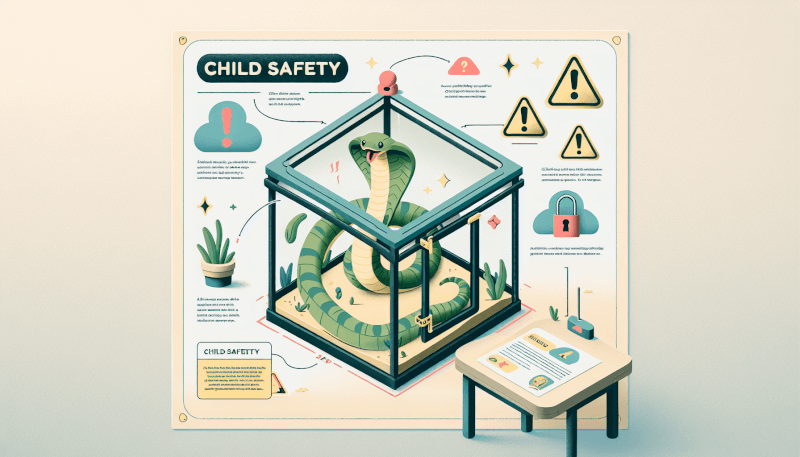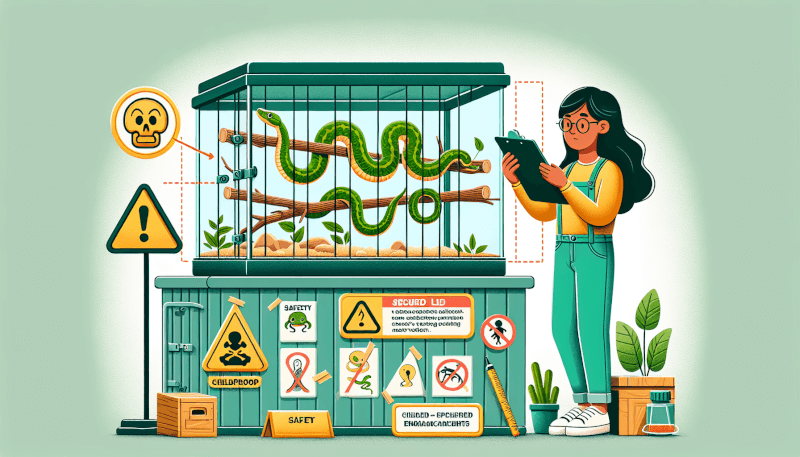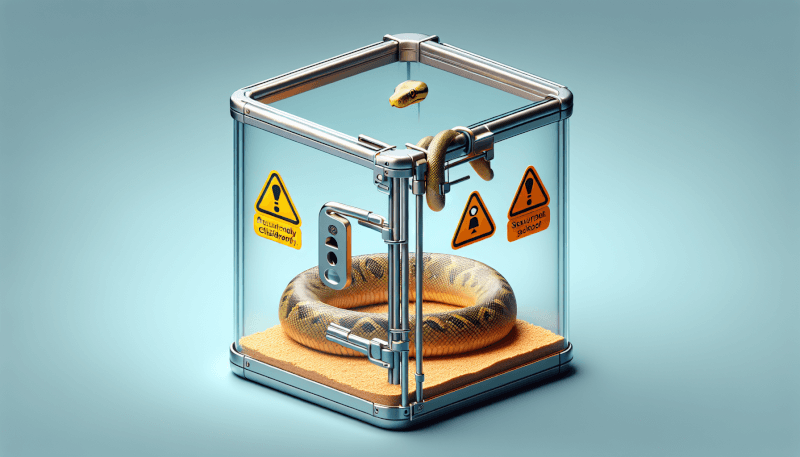Are you a proud snake owner who also happens to have young children? Ensuring the safety of both your children and your slithery pet is of utmost importance. In this informative article, you will discover valuable tips on how to childproof a snake’s enclosure, allowing you to create a secure environment for your reptile friend while keeping curious little hands safe from harm. With these simple yet effective strategies, you can have peace of mind knowing that your children and snake can coexist safely and happily in your home.
Choosing the Right Enclosure
When it comes to housing a pet snake, selecting the appropriate enclosure is crucial for both the safety of the snake and the peace of mind of its owner. There are a few key factors to consider when choosing the right enclosure, such as the cage size and the type of enclosure. Additionally, ventilation and temperature considerations play a vital role in creating a suitable habitat for your slithery friend.
Selecting the Appropriate Cage Size
The size of your snake’s enclosure is of utmost importance. Snakes need enough space to move around freely and stretch out. A general rule of thumb is to provide an enclosure that is at least as long as your snake’s length and about its double width. This ensures that your snake will have ample room to climb, explore, and engage in natural behaviors.
Choosing the Right Type of Enclosure
There are various types of enclosures available on the market, such as glass terrariums, plastic tubs, and wooden vivariums. Each type has its advantages and disadvantages, so it is essential to consider factors like durability, visibility, and insulation when making your choice. Ultimately, the selected enclosure should provide a secure and comfortable living space for your snake.
Optimal Ventilation and Temperature Considerations
Proper ventilation is crucial for maintaining good air quality within the enclosure. Ensure that your chosen enclosure has adequate ventilation grilles or mesh to allow for the free flow of air. Additionally, snake enclosures require specific temperature conditions to ensure the health and well-being of the reptile. Provide both a warm and a cool area within the enclosure, allowing the snake to regulate its body temperature effectively.
Removing Potential Hazards
Before introducing your snake to its new habitat, it is essential to eliminate any potential hazards that may pose a risk to its safety. Taking the time to address sharp edges or protrusions, secure loose parts and accessories, and ensure solid construction will greatly reduce the chances of accidents or injuries.
Eliminating Sharp Edges or Protrusions
Carefully inspect the enclosure for any sharp edges or protrusions that could harm your snake. Sand down or cover any rough surfaces to create a smooth environment within the enclosure. Remember, snakes have delicate skin, and any sharp objects can cause cuts or abrasions.
Securing Loose Parts and Accessories
Loose parts and accessories within the enclosure can be dangerous. Snakes are curious creatures, and they may attempt to play with or ingest objects that are not securely attached. Always ensure that any decorations, hiding spots, or climbing branches are firmly fixed to prevent accidental collapse, which can harm your snake.
Ensuring Solid Construction
When selecting or building your snake’s enclosure, prioritize solid construction. A flimsy or poorly constructed enclosure can pose a significant threat to your snake’s safety. Invest in a sturdy and reliable enclosure that can withstand any attempts at escape or destructive behavior from your curious snake.
Installing Secure Locks
A secure lock is essential to prevent unauthorized access to your snake’s enclosure. Snakes are interactive animals, and they may try to escape if given the opportunity. Taking the necessary precautions to choose reliable locking mechanisms, regularly test and inspect the locks, and keep the lock keys out of reach will ensure that your snake remains safely enclosed.
Choosing Reliable Locking Mechanisms
Selecting a reliable locking mechanism is critical to maintain the integrity of your snake’s enclosure. Consider using secure locks, such as padlocks or combination locks, that are difficult for children or unauthorized individuals to open accidentally. Make sure the lock is compatible with your chosen enclosure type.
Testing and Inspecting Locks Regularly
Regularly test the locks on your snake’s enclosure to ensure they are functioning correctly. Locks can deteriorate over time, and it is crucial to identify any issues before they become a security risk. Additionally, inspect the locks for signs of wear or damage. Replace any faulty locks promptly to maintain a secure environment for your pet snake.
Keeping Lock Keys Out of Reach
To prevent unintended access to the snake’s enclosure, it is vital to keep the lock keys out of reach. Store the keys in a secure location that is inaccessible to children and other unauthorized individuals. Always remember to double-check that the enclosure is properly locked before leaving the room.
Creating a Safe Environment
Creating a safe environment for your snake involves several considerations, such as using non-toxic materials, avoiding exposed wiring or cords, and preventing humidity or moisture accumulation. These measures will ensure that your snake’s living space is free from potential dangers.
Using Non-Toxic Materials
Snakes love to explore their surroundings, often using their tongues to investigate objects. Ensure that all materials used in the enclosure and its decorations are non-toxic. Avoid using substances such as paint, glue, or cleaning products that could emit harmful fumes or be ingested by your snake.
Avoiding Exposed Wiring or Cords
Exposed electrical wiring or cords can be hazardous for both your snake and your household. Snakes may chew on or become entangled in these items, risking electrical shocks or injuries. Keep all wires and cords organized and secured, either by covering them or placing them out of reach in protective tubing.
Preventing Humidity or Moisture Accumulation
Maintaining appropriate levels of humidity within your snake’s enclosure is vital to its overall health. However, excessive humidity or moisture accumulation can lead to mold, fungus growth, or respiratory problems for your snake. Regularly monitor humidity levels and use proper ventilation techniques to prevent excessive moisture build-up.
Optimizing Habitat Conditions
To ensure the well-being of your snake, it is essential to optimize habitat conditions by providing adequate space for movement, ensuring proper lighting and heating, and maintaining appropriate humidity levels. These factors closely mimic the snake’s natural environment and promote a healthy and content pet.
Providing Adequate Space for Movement
Snakes need ample space to move around, stretch, and perform natural behaviors like climbing and burrowing. Make sure the enclosure is spacious enough to allow the snake to explore its environment comfortably. Provide appropriate hiding spots and climbing branches to encourage natural behaviors and promote healthy physical and mental exercise.
Ensuring Proper Lighting and Heating
Snakes are ectothermic creatures, relying on external heat sources to regulate their body temperature. Consider installing appropriate heating equipment, such as heat pads or heat lamps, to create temperature gradients within the enclosure. Additionally, provide a suitable light source to mimic the natural day-night cycle, promoting a sense of normalcy for your snake.
Maintaining Appropriate Humidity Levels
Different snake species have varying humidity requirements. Research and understand the specific needs of your snake before setting up its enclosure. Use hygrometers to monitor humidity levels accurately and make adjustments as necessary. Mist the enclosure with water or use a humidifier if your snake requires higher humidity levels.
Selecting Safe Substrate
The substrate, or bedding, in your snake’s enclosure serves various purposes, including moisture regulation, hygiene, and providing a comfortable surface for your snake to rest on. Choosing the right substrate involves ensuring it is free from sharp or ingestible materials, easy to clean, and monitoring moisture levels to prevent mold or bacterial growth.
Avoiding Sharp or Ingestible Materials
Select a substrate that does not contain any sharp or dangerous materials that could harm your snake. Avoid substrates with large particles or pieces that can potentially be ingested, leading to digestive issues. Choose options made from materials like aspen shavings, cypress mulch, or reptile-specific carpeting, as these tend to be safe and comfortable for your snake.
Choosing Substrate Easy to Clean
Cleaning the snake’s enclosure is an essential part of maintaining a safe and healthy environment. Selecting a substrate that is easy to clean and replace is essential. Some substrates, such as newspaper or reptile carpet, offer convenience in terms of cleaning, as they can be easily removed and replaced. Regularly inspect and sanitize the enclosure to prevent the buildup of bacteria or parasites.
Monitoring Substrate Moisture Levels
Different snake species have specific moisture requirements for their bedding. Some snakes, like those from arid environments, may need drier substrates, while others, such as those from tropical regions, require more humidity. Regularly check the moisture levels in the substrate and make adjustments accordingly to prevent excessive dryness or excessive moisture.
Ensuring Proper Ventilation
Adequate ventilation within the snake’s enclosure is crucial to maintain good air quality. Proper ventilation helps prevent the accumulation of harmful gases, such as ammonia, and ensures the circulation of fresh air. Installing ventilation grilles or mesh and keeping air vents clear are necessary steps to ensure optimal air circulation.
Installing Ventilation Grilles or Mesh
To promote proper air exchange, install ventilation grilles or mesh on the sides, top, or back of the enclosure. These allow fresh air to enter while allowing stale air to exit. The size and location of the ventilation openings should be chosen carefully, considering the specific needs of your snake species.
Keeping Air Vents Clear
Ensure that any air vents or openings in the enclosure are not blocked by decorations, bedding, or other objects. Blocked vents can restrict airflow, leading to poor air quality and a higher risk of respiratory issues for your snake. Regularly check and clean the vents to prevent any blockages from impeding air circulation.
Maintaining Adequate Air Circulation
In addition to ventilation grilles or mesh, it is essential to promote adequate air circulation within the room where the snake’s enclosure is located. Stagnant air can contribute to moisture accumulation or the buildup of harmful gases. Use fans or open windows when possible to promote fresh air exchange in the room.
Placing Enclosure in a Safe Location
Choosing the right location for your snake’s enclosure is vital to its well-being. Avoid placing the enclosure in direct sunlight or drafts, keep it elevated to prevent access by other pets or small children, and maintain an ideal room temperature for the comfort of your snake.
Avoiding Direct Sunlight or Drafts
Direct sunlight can cause temperature fluctuations within the enclosure, making it challenging for your snake to regulate its body temperature effectively. Additionally, drafts can lead to rapid heat loss or introduce cold air, creating an uncomfortable or even dangerous environment for your snake. Choose a location away from direct sunlight and regions with drafts.
Keeping the Enclosure Elevated
Elevating the snake’s enclosure helps prevent accidental access by other pets, such as cats or dogs, or small children who may be curious about the snake. Choose a secure and stable surface, such as a snake rack or a table, to elevate the enclosure off the ground.
Selecting an Ideal Room Temperature
Snakes are ectothermic animals and rely on external heat sources to regulate their body temperature. Ensure that the room where the enclosure is located maintains an ideal temperature range for your snake’s species. Monitor the temperature regularly and make adjustments as necessary to ensure the comfort and well-being of your pet snake.

Educating Children about Snake Safety
If you have children in your household, it is crucial to educate them about snake safety. Teaching children about snake behavior, explaining the importance of proper handling, and instilling respect and awareness can help foster a harmonious and safe environment for both children and snakes.
Teaching Children about Snake Behavior
Children should be educated about snake behavior to understand their natural instincts and habits. Teach them to recognize signs of aggression, fear, or stress in snakes, helping them avoid handling the snake during these times. Explain the importance of respecting the snake’s space and boundaries.
Explaining the Importance of Proper Handling
Proper handling techniques are essential when interacting with snakes. Teach children to handle snakes gently and avoid any sudden movements or loud noises that may startle the snake. Emphasize the importance of supporting the snake’s body correctly and avoiding any actions that may stress or harm the snake.
Instilling Respect and Awareness
Children should develop a healthy respect and awareness of snakes. Teach them that snakes are not toys and should not be treated as such. Encourage them to appreciate snakes from a safe distance and understand the crucial role these creatures play in nature. By fostering respect and awareness, children are more likely to act responsibly around snakes.
Supervising Interactions between Children and Snake
When children and snakes interact, it is crucial to provide adequate supervision to ensure the safety of both the child and the snake. Never leave children unattended, establish clear rules and boundaries, and consider training children on proper handling techniques to minimize any risks.
Never Leaving Children Unattended
Children should never be left alone with a snake, regardless of the size or nature of the snake. Accidents can happen quickly, and it is the responsibility of adults to supervise any interactions between children and snakes at all times.
Establishing Clear Rules and Boundaries
Establish clear rules for children when it comes to interacting with snakes. Teach them not to disturb the snake’s enclosure without adult supervision and to avoid touching the snake without permission. Encourage open communication between adults and children to address any concerns or questions regarding snake safety.
Training Children on Proper Handling Techniques
Consider providing educational resources or training sessions for children to learn proper handling techniques. This could include demonstrations on how to approach, hold, and safely return a snake to its enclosure. Proper training enhances children’s confidence while minimizing the risk of accidental harm to both the snake and the child.
Ensuring the safety of your snake requires thoughtful consideration and careful planning. By following these guidelines and incorporating childproofing measures into your snake’s enclosure, you can provide a secure habitat for your beloved pet while promoting a positive and educational experience for children in your household. Remember, responsible snake ownership involves ongoing vigilance and a commitment to the well-being of both your snake and those interacting with it.



